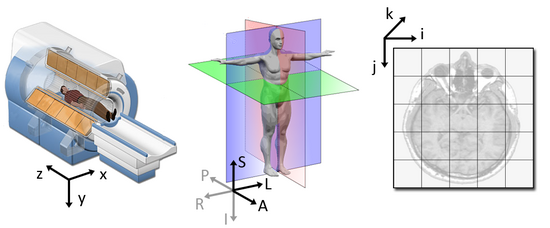Coordinate systems
Introduction
One of the great issues while dealing with medical images and applications are the differences between the coordinate systems. There are three coordinate systems commonly used in medical applications: a difference can be made between the world, anatomical and the image coordinate system.
The following figure illustrates the three spaces with their corresponding axes:
Each coordinate system serves one purpose and represents their data in different ways:
- The world coordinate system is typically a cartesian coordinate system in which a model (e.g. a MRI scanner or a patient) is positioned. Every model has its own coordinate system but there is only one world coordinate system to define the position and orientation of each model.
- The most important model coordinate system for medical imaging techniques is the anatomical space. This space consists of three planes to describe the standard anatomical position of a human:
- the axial plane is parallel to the ground and separates the head (Superior) from the feet (Inferior)
- the coronal plane is perpendicular to the ground and separates the front from (Anterior) the back (Posterior)
- the sagittal plane separates the Left from the Right
.... From these planes it follows that all axes have their notation in a positive direction (e.g. the negative Superior axis is represented by the Inferior axis).
- The image coordinate system describes how the images were acquired with respect to the anatomy. Medical scanners create regular, rectangular arrays of points and cells which start at the upper left corner. The i axis increases to the right, the j axis to the bottom and the k axis backwards.
The relationship between the anatomical coordinate system and the image coordinate system
The anatomical coordinate system (also called patient coordinate system) is a continuous three-dimensional space in which an image has been sampled. In neuroimaging, it is common to define this space with respect to the human whose brain is being scanned. Hence the 3D basis is defined along the anatomical axes of anterior-posterior, inferior-superior, and left-right.
However different medical applications use different definitions of this 3D basis. Most common are the following:
- LPS (Left, Posterior, Superior), which is used in DICOM images and by the ITK toolkit
- RAS (Right, Anterior, Superior) is similar to LPS with the first two axes flipped used in 3D Slicer
3rdCaption
text
